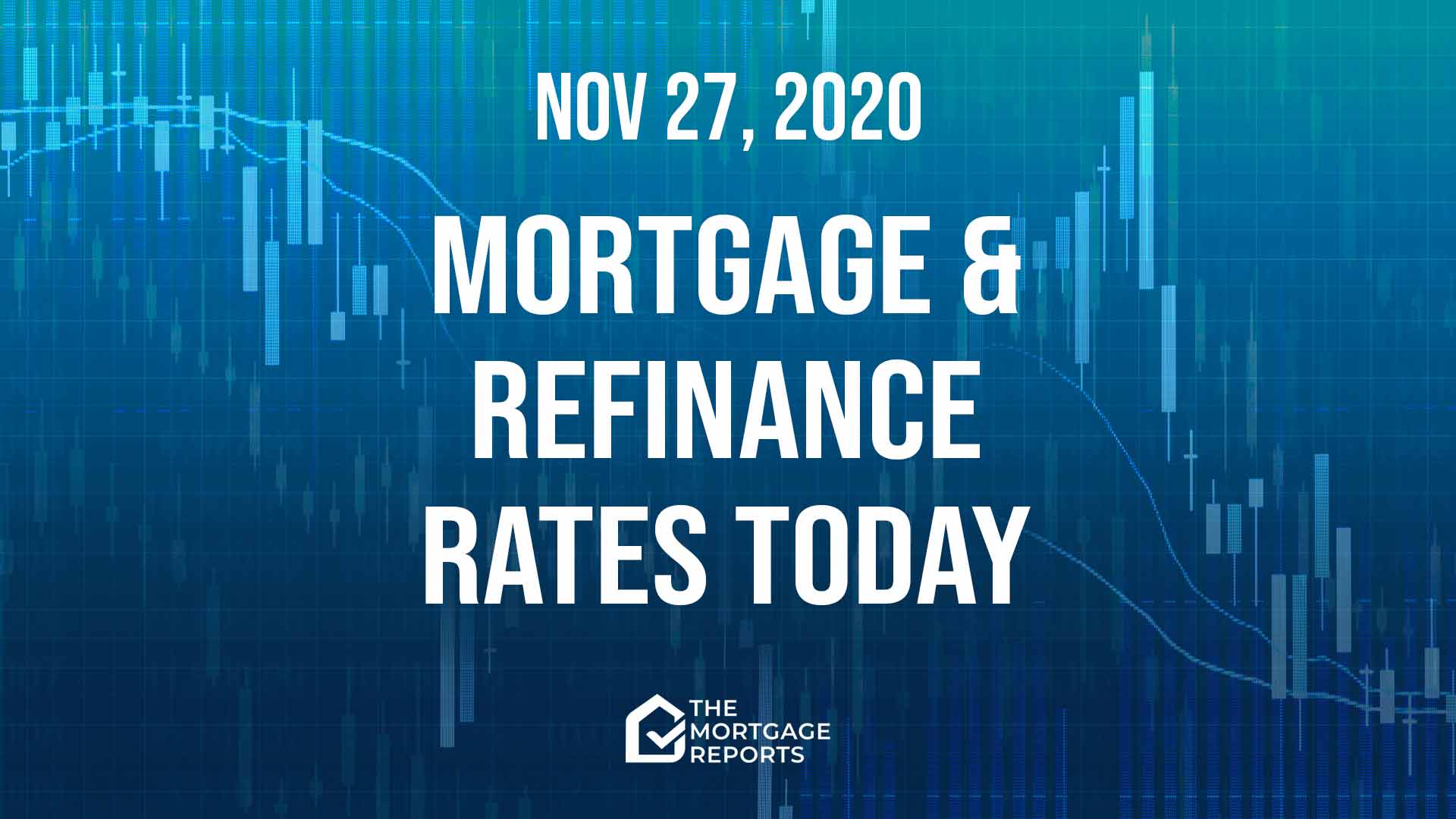
Today’s mortgage and refinance rates
Average mortgage rates inched lower on Wednesday, as we predicted. And conventional loans started out this morning at 3.063% (3.063% APR) for a 30-year, fixed-rate mortgage.
There’s only a half-day’s trading today. And no economic reports are due to be published. So changes this morning are likely to be a continuation of Wednesday’s sentiment. And so far it’s looking as if mortgage rates may hold steady or fall a little.
Find and lock a low rate (Nov 27th, 2020)Current mortgage and refinance rates
| Program | Mortgage Rate | APR* | Change |
|---|---|---|---|
| Conventional 30 year fixed | |||
| Conventional 30 year fixed | 3.063% | 3.063% | Unchanged |
| Conventional 15 year fixed | |||
| Conventional 15 year fixed | 3% | 3% | Unchanged |
| Conventional 5 year ARM | |||
| Conventional 5 year ARM | 3% | 2.743% | Unchanged |
| 30 year fixed FHA | |||
| 30 year fixed FHA | 2.938% | 3.919% | Unchanged |
| 15 year fixed FHA | |||
| 15 year fixed FHA | 2.125% | 3.065% | Unchanged |
| 5 year ARM FHA | |||
| 5 year ARM FHA | 2.5% | 3.226% | Unchanged |
| 30 year fixed VA | |||
| 30 year fixed VA | 2.875% | 3.053% | Unchanged |
| 15 year fixed VA | |||
| 15 year fixed VA | 2% | 2.319% | Unchanged |
| 5 year ARM VA | |||
| 5 year ARM VA | 2.5% | 2.406% | Unchanged |
| Rates are provided by our partner network, and may not reflect the market. Your rate might be different. Click here for a personalized rate quote. See our rate assumptions here. | |||
COVID-19 mortgage updates: Mortgage lenders are changing rates and rules due to COVID-19. To see the latest on how coronavirus could impact your home loan, click here.
Should you lock a mortgage rate today?
It’s hard to imagine what might drive big changes in mortgage rates today. And I think they’re most likely to remain unchanged or maybe inch a little lower.
So I wouldn’t lock today unless I were near to closing. And that’s because I suspect yet lower rates are in prospect.
See “Are mortgage and refinance rates rising or falling?” (below) for more. Meanwhile, my personal rate lock recommendations are:
- LOCK if closing in 7 days
- LOCK if closing in 15 days
- FLOAT if closing in 30 days
- FLOAT if closing in 45 days
- FLOAT if closing in 60 days
But with so much uncertainty at the moment, your instincts could easily turn out to be as good as mine — or better. So be guided by your gut and your personal tolerance for risk.
Market data affecting today’s mortgage rates
Here’s the state of play this morning at about 9:50 a.m. (ET). The data, compared with about the same time last Friday morning, were:
- The yield on 10-year Treasurys inched down to 0.85% from 0.86%. (Good for mortgage rates) More than any other market, mortgage rates normally tend to follow these particular Treasury bond yields, though less so recently
- Major stock indexes were mostly modestly higher on opening. (Bad for mortgage rates.) When investors are buying shares they’re often selling bonds, which pushes prices of those down and increases yields and mortgage rates. The opposite happens when indexes are lower
- Oil prices were effectively unchanged at $45.20 from $45.37 a barrel. (Bad for mortgage rates* because energy prices play a large role in creating inflation and also point to future economic activity.)
- Gold prices fell to $1,782 from $1,813 an ounce. (Bad for mortgage rates*.) In general, it’s better for rates when gold rises, and worse when gold falls. Gold tends to rise when investors worry about the economy. And worried investors tend to push rates lower
- CNN Business Fear & Greed index — Inched up to 91 from 90 out of 100. (Bad for mortgage rates.) “Greedy” investors push bond prices down (and interest rates up) as they leave the bond market and move into stocks, while “fearful” investors do the opposite. So lower readings are better than higher ones
Caveats about markets and rates
Before the pandemic and the Federal Reserve’s interventions in the mortgage market, you could look at the above figures and make a pretty good guess about what would happen to mortgage rates that day. But that’s no longer the case. The Fed is now a huge player and some days can overwhelm investor sentiment.
So use markets only as a rough guide. They have to be exceptionally strong (rates are likely to rise) or weak (they could fall) to rely on them. But, with that caveat, they’re looking a little worse for mortgage rates today.
Find and lock a low rate (Nov 27th, 2020)
Important notes on today’s mortgage rates
Here are some things you need to know:
- The Fed’s ongoing interventions in the mortgage market (way over $1 trillion) should put continuing downward pressure on these rates. But it can’t work miracles all the time. So expect short-term rises as well as falls. And read “For once, the Fed DOES affect mortgage rates. Here’s why” if you want to understand this aspect of what’s happening
- Typically, mortgage rates go up when the economy’s doing well and down when it’s in trouble. But there are exceptions. Read How mortgage rates are determined and why you should care
- Only “top-tier” borrowers (with stellar credit scores, big down payments and very healthy finances) get the ultralow mortgage rates you’ll see advertised
- Lenders vary. Yours may or may not follow the crowd when it comes to daily rate movements — though they all usually follow the wider trend over time
- When rate changes are small, some lenders will adjust closing costs and leave their rate cards the same
- Refinance rates are typically close to those for purchases. But some types of refinances from Fannie Mae and Freddie Mac are currently appreciably higher following a regulatory change
So there’s a lot going on here. And nobody can claim to know with certainty what’s going to happen to mortgage rates in coming hours, days, weeks or months.
Are mortgage and refinance rates rising or falling?
Today
My best guess is that mortgage rates are likely to hold steady or inch lower today.
I continue to expect mortgage rates to continue to fall very gently as an overall trend. But (hopefully brief) periods of slightly higher rates are inevitable.
That expectation is based on the huge damage to the American and global economies that the pandemic is wreaking. Typically, the worse the economy, the lower mortgage rates go.
True, that damage might eventually be moderated by vaccines. But their public health effects are unlikely to become appreciable until the middle of next year — or even later.
Possible future threat?
There’s one possible blot on the horizon for lower rates. That’s an announcement on Dec. 16 that follows a meeting of the Federal Open Market Committee (FOMC), which is the Federal Reserve’s policy body.
We already know that the FOMC discussed reviewing its purchases of mortgage-backed securities (MBSs, the bonds that actually determine mortgage rates) at its last meeting. And if it decides to stop or significantly reduce those, mortgage rates could rise that day and thereafter, perhaps sharply.
Personally, I think the FOMC is unlikely to sacrifice the golden goose (the housing market) that offers rare comfort amid the current economic mayhem. But others are concerned. And you should know of this threat.
Recently
Over the last few months, the overall trend for mortgage rates has clearly been downward. A new all-time low was set during each of the weeks ending Oct. 15 and 22 and Nov. 5 and 19 according to Freddie Mac. Last Thursday’s record low was the 13th this year. This week, Freddie said they held steady.
But note that Freddie’s figures relate to purchase mortgages alone and ignore refinances. And if you average out across both, rates have been consistently higher than the all-time low since a record set in August. The gap between the two has been widened by a controversial regulatory change.
Expert mortgage rate forecasts
Looking further ahead, Fannie Mae, Freddie Mac and the Mortgage Bankers Association (MBA) each has a team of economists dedicated to monitoring and forecasting what will happen to the economy, the housing sector and mortgage rates.
And here are their current rates forecasts for the last quarter of 2020 (Q4/20) and the first three of 2021 (Q1/21, Q2/21 and Q3/21).
But note that Fannie’s (released on Nov. 17) and the MBA’s (also Nov. 17) are updated monthly. However, Freddie’s are now published quarterly. And its latest was released on Oct. 14.
The numbers in the table below are for 30-year, fixed-rate mortgages:
| Forecaster | Q4/20 | Q1/21 | Q2/21 | Q3/21 |
| Fannie Mae | 2.8% | 2.8% | 2.8% | 2.8% |
| Freddie Mac | 3.0% | 3.0% | 3.0% | 3.0% |
| MBA | 2.9% | 3.0% | 3.0% | 3.2% |
So predictions vary considerably. You pays yer money …
Find your lowest rate today
Some lenders have been made nervous by the pandemic. And they’re restricting their offerings to just the most vanilla-flavored mortgages and refinances.
But others remain brave. And you can still probably find the cash-out refinance, investment mortgage or jumbo loan you want. You just have to shop around more widely.
But, of course, you should be comparison shopping widely, no matter what sort of mortgage you want. As federal regulator the Consumer Financial Protection Bureau says:
Verify your new rate (Nov 27th, 2020)Shopping around for your mortgage has the potential to lead to real savings. It may not sound like much, but saving even a quarter of a point in interest on your mortgage saves you thousands of dollars over the life of your loan.



